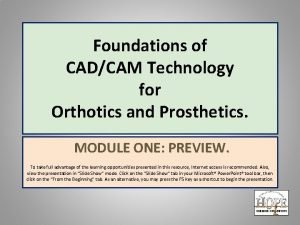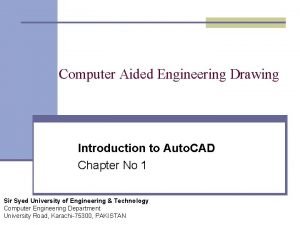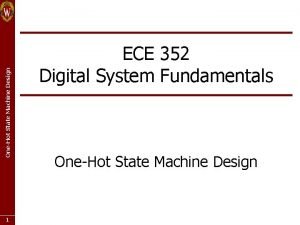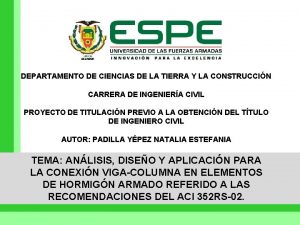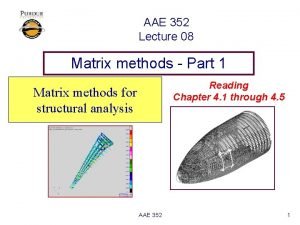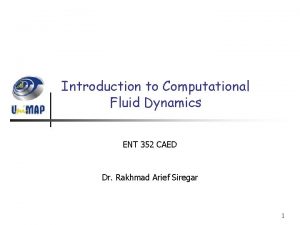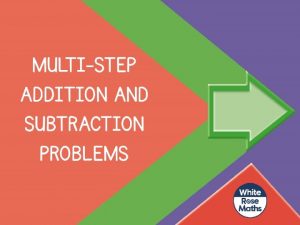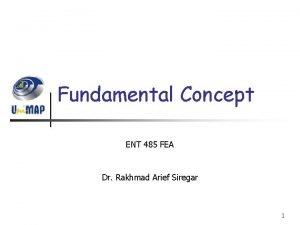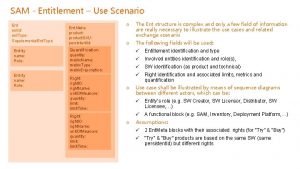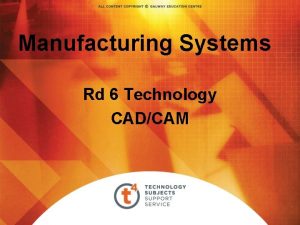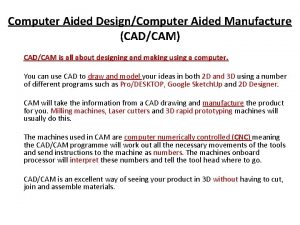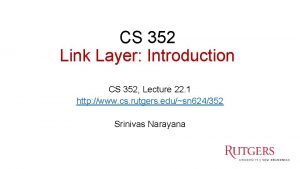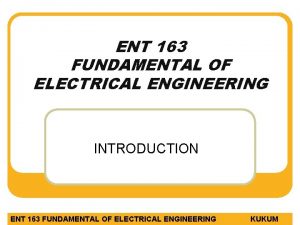Introduction to CADCAM ENT 352 CAED Dr Rakhmad















- Slides: 15

Introduction to CAD/CAM ENT 352 CAED Dr. Rakhmad Arief Siregar 1

Introduction n In general, a Computer Aided Design (CAD) package has three components: n n n Design, Analysis Visualization 2

Introduction n Design: Design refers to geometric modeling, i. e. , 2 -D and 3 -D modeling, including, drafting, part creation, creation of drawings with various views of the part, assemblies of the parts, etc. Analysis: Analysis refers to finite element analysis, optimization, and other number crunching engineering analyses. In general, a geometric model is first created and then the model is analyzed for loads, stresses, moment of inertia, and volume, etc. Visualization: Visualization refers to computer graphics, which includes: rendering a model, creation of pie charts, contour plots, shading a model, sizing, animation, etc 3

Computer Aided Manufacturing (CAM) n n n CAM is the next stage of CAD A part created in CAD can be downloaded and manufactured, without a human hand touching the part The process is called CAM, and involves CAD, Networking, and NC programming 4

Concurrent Engineering n Concurrent Engineering is another powerful CAD concept that has evolved in the 90’s n n n This concept, there is an instantaneous communication between the designer, analyst, and manufacturing. Changes made at any of these work centers are immediately passed on to the others and the product is modified without delay. The customer, management, and the marketing people join in and become part of the process. It saves the valuable time and helps get the product out in the market quicker. Products that use to take years from the date of its concept to the actual production now take only a few weeks, and the final product is better and cost-effective. Some large organizations have invested in Rapid Prototyping process. In this process, the part is created by a CAD package and downloaded into the rapid prototyping machine; the machine immediately manufactures the part, using a plastic material. 5

CAD/CAM History n n n The concept of CAD and CAM is relatively new. The usage is linked with the development of computers. The actual application of CAD/CAM in industry, academia and government is only approximately 30 years old. Formal courses in CAD and Finite Element Analysis (FEA) were introduced in 1970’s. The major application thrust of CAD came in 1980’s, with the availability of PCs and workstations. 6

CAD/CAM History n 1960’s n n n Development in Interactive computer graphics research Sketchpad system developed by Ivan Sutherland in 1962 CAD term coined First major commercial CAD/CAM software available: CADAM by Lockheed, in 1965 Bell Telephone’s - Graphics 1 remote display system developed 1970’s n n n n Application of CAM in government, industry and academia National organization formed Beginning of usage of computer graphics Turnkey system available for drafting Wireframe and surface modeling software became available Mass property calculation and FEA software became available NC tape generating, verification, and integrated circuit software became available 7

CAD/CAM History n 1980’s n n n CAD/CAM used for engineering research and development New CAD/CAM theories and algorithms developed Integration of CAD/CAM Solid modeling software became available Use of PCs and workstation began 1990’s n n n Concept of concurrent engineering developed Increased use of CAD/CAM on PCs and worksations Improvements in hardware and software 8

Inside CAD n n Transformation is the backbone of computer graphics, enabling us to manipulate the shape, size, and location of the object. It can be used to effect the following changes in a geometric object n n n n Change the location Change the Shape Change the size Rotate Copy Generate a surface from a line Generate a solid from a surface Animate the object 9

Inside CAD n n For uniform scaling, the scaling transformation matrix is given as For Non-uniform scaling, the scaling transformation matrix is given as 10

Ex. 1 n n n If the triangle A(1, 1), B(2, 1), C(1, 3) is scaled by a factor 2, find the new coordinates of the triangle. Solution Writing the points matrix in homogeneous coordinates, we have 11

Ex. 1 n The scaling transformation matrix is, 12

Ex. 1 13

CAD/CAM SYSTEMS 14

Inside CAM n NC programming n N 10 G 00 G 20 G 49 G 80 G 98 (1/4" SLOT DRILL) N 12 T 3 M 06 N 14 S 10000 M 03 N 16 G 00 G 54 G 43 X 0. 25 Y 0. 1 Z 1. H 03 M 08 N 18 Z 0. 1 N 20 G 99 G 81 Z-. 1 R. 05 F 12. N 22 X 0. 5 Y 0. 1 N 24 X 0. 75 Y 0. 1 N 26 X 1. 0 Y 0. 1 N 28 X 1. 25 Y 0. 1 15
